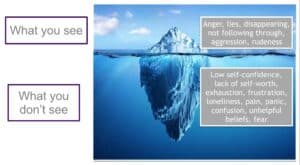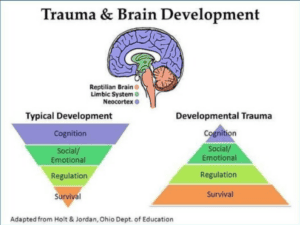What does brain science have to do with poverty? Quite a bit actually. And understanding how the brain works is a vital component of our work with clients.
Poverty is exhausting.
And when you’re trapped in the cycle, hopelessness often sets in. Asking for help is hard enough, and even harder when you’re having to do it over and over and over.
Crisis. Panic. Scramble. Get help. Take a deep breath and try again.
Kimberly Lawrence, Padua Case Manager Supervisor, goes in-depth about how this cycle impacts those we serve and why making change happen is not only hard but nearly impossible without intervention.
We work with people who want their lives to be different but are usually unsure of how to make that happen.
What does brain science teach us about behavior and how does this knowledge inform our work?
 From a distance, it’s easy to ascribe intent to behavior. For example, if a client is angry or doesn’t show up, it’d be easy to just assume they don’t care or don’t want help. But brain science tells us a different and more complete story. All “misbehavior” points to an unmet need. Our case managers work to identify these unmet needs and start from a place of respectful curiosity.
From a distance, it’s easy to ascribe intent to behavior. For example, if a client is angry or doesn’t show up, it’d be easy to just assume they don’t care or don’t want help. But brain science tells us a different and more complete story. All “misbehavior” points to an unmet need. Our case managers work to identify these unmet needs and start from a place of respectful curiosity.
Respectful curiosity
…means wanting to learn what is leading to the behavior we see.
…requires believing the client is worthy of having their needs met.
…leads to helping the client begin to believe they are worthy.
Our brain develops from the bottom up and the cortex, or our “thinking brain” is the last to develop. And brain development is triggered by experiences. So, through our individual experiences, we learn and make connections. Our experiences trigger brain development, or learning, which is actually the process of making connections.
Watch as Kimberly explains the impact our experiences have on our brain development, and as a result, our decisions.
The Impact of Trauma
One thing almost all our clients have in common is trauma.
For example, if mom or dad is never around because they’re off scoring drugs or working three jobs to hold down a place to live — their kiddo isn’t going to have someone to teach them to regulate their emotions.
Many of our clients have lived in fight or flight survival mode for their whole lives.
In typical brain development, emotion regulation supports growth in planning and cognition. But, if the brain switches into survival gear, the lights go out in the cortex and there’s very little capacity to focus on more than today.
So, it’s not that our clients don’t know how to regulate their emotions and don’t have people skills. In many cases, they never actually had the chance to develop the skills and abilities it takes to create plans and problem solve and follow through. They are stuck in limbic fight or flight.
How Do We Help?
The brain can continue to grow and develop throughout life. We learn by doing. Have you ever noticed that when you do something over and over again, it becomes a habit and it’s easy to just default to it? That’s because your brain has created a highway connection.
In conversations about poverty, we often hear judgment about those in poverty. “Why would someone behave that way or make that bad decision when it doesn’t help them move forward?” Because people do what makes sense based on their experience. And what helps you survive in one world doesn’t necessarily translate to another.
If lying about what you did today keeps your husband from beating you, that same survival strategy, lying, doesn’t keep your boss from firing you when you’re late. Neurons that fire together, wire together, so if the brain created a connection between lying and avoiding danger, then that connection can’t be undone. Instead, the brain will have to build a new connection that it’s possible to avoid danger without lying.
Shifting the paradigm of what has been learned for a lifetime takes time. Years.
How Do We Help With This Process?
We start with ourselves.
Watch as Kimberly explains what this can look like.
We are a privileged witness to change.
We hold the space for our clients to move forward and we use brain science to do it. We call it SCARF for short. Each letter represents one of the elements that determine whether our feeling brain panics and sends us to fight or flight or relaxes and opens the doorway to our thinking brain to begin working toward our goals. So, what do these letters stand for?
Status:
This one is about feeling valued. So, we respect each client’s dignity and worth.
Certainty:
Knowing what to expect is important. That’s why we use the same approach to every meeting, work transparently, and do what we say we’ll do.
Autonomy:
We don’t make the decisions, the client does. The client tells us where we’re going—what THEIR bigger, brighter future looks like—and sets the action steps to get there.
Relatedness:
A sense of safety with others and belonging. We let them know we’re here for as long as it takes, we won’t judge, and we will make sure we all stay on the same page.
Fairness:
A perception of being treated fairly. We let them know that this is the way the program works for everyone.
Watch as Kimberly explains what this approach makes possible.
So, what does success look like?
It looks like Mr. M. We first met Mr. M after he had just gotten out of prison for the 6th time. He wanted to stay out this time. He said he had been clean for a month now and he was tired of running and drugging. He said it wasn’t right by his faith. And he had just gotten the second job he’d ever worked in his life. It was the week before his 48th birthday. He had heart problems and joint problems and blood pressure issues from a life of drugs and living on the street. And he was missing an eye because it was impaled by a branch when he was running through the woods to get away from the cops. He had very little, very poor education and multiple felonies on his record. And he was homeless. It was hard to even know where to start. But we did start. And he got housed, employed, banked, in recovery support and therapy, and earned a culinary certification. Our work wasn’t problem-solving as much as strength evoking. And everything that looked like such a barrier on paper was just an outcome of unresolved trauma.
Mr. M is one of many amazing clients we’ve been able to work with through this journey. Growing is a process and it’s hard and messy and non-linear. And it’s important to keep in mind what success looks like.
Success looks like each period of progress being longer than the last. Success looks like a client leaning in and learning from a setback instead of running away.
And we stick with them. We stay. Through the success and the struggle.
Because success is holistic, strengths-based, client-led, and non-judgmental.
Success is highly trained staff with respectful curiosity partnering with people who really want to change their lives. It’s people beginning to feel safe and getting unstuck and beginning to form new neural pathways.
It’s people beginning to believe they are worthy of living their best life.
To watch Kimberly’s full presentation, visit our Youtube channel here.


